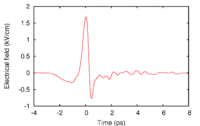Terahertz time-domain spectroscopy

Terahertz time-domain spectroscopy is a way to study very tiny things that we can't see with our own eyes. It's like having special glasses that allow us to see things that are too small for our regular eyes to see.
To understand how it works, imagine playing with a toy car that you can control with a remote. If you turn the remote on, the car moves forward. If you turn it off, the car stops. In a similar way, things in our world are made up of tiny particles that move around when we apply certain types of energy.
Terahertz time-domain spectroscopy uses energy called terahertz waves to study these tiny particles. These waves are like music notes that are too high for us to hear, but are perfect for studying things that are too small to see.
When we shine terahertz waves on a tiny object, like a piece of metal or a plastic bottle, they cause the particles inside the object to move around. The terahertz waves bounce back off the object and we can use a special machine to measure how they bounce back.
By measuring how the waves bounce back, we can get a lot of information about the tiny particles inside the object. We can learn things like how fast they are moving, how they are arranged, and what they are made of.
Scientists use terahertz time-domain spectroscopy to study all sorts of things, from materials that are used to make buildings to the medicines we take to stay healthy. It's like having a magic tool that lets us see things that are too small for our regular eyes to see, and learn about the world in a whole new way!
To understand how it works, imagine playing with a toy car that you can control with a remote. If you turn the remote on, the car moves forward. If you turn it off, the car stops. In a similar way, things in our world are made up of tiny particles that move around when we apply certain types of energy.
Terahertz time-domain spectroscopy uses energy called terahertz waves to study these tiny particles. These waves are like music notes that are too high for us to hear, but are perfect for studying things that are too small to see.
When we shine terahertz waves on a tiny object, like a piece of metal or a plastic bottle, they cause the particles inside the object to move around. The terahertz waves bounce back off the object and we can use a special machine to measure how they bounce back.
By measuring how the waves bounce back, we can get a lot of information about the tiny particles inside the object. We can learn things like how fast they are moving, how they are arranged, and what they are made of.
Scientists use terahertz time-domain spectroscopy to study all sorts of things, from materials that are used to make buildings to the medicines we take to stay healthy. It's like having a magic tool that lets us see things that are too small for our regular eyes to see, and learn about the world in a whole new way!
Related topics others have asked about:
